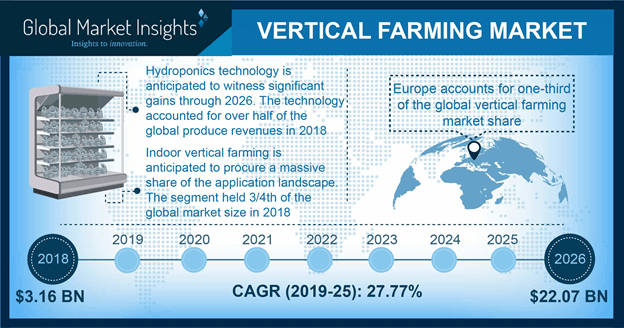APAC vertical farming market to register the highest growth rate over 2018-2024, aeroponics to emerge as a popular technology
Publisher : Fractovia | Published Date : 2018-10-09Request Sample
Alternative farming techniques, having gained momentum to combat the unavailability of land space, are majorly contributing toward vertical farming market growth lately. Vertical farming is the latest phenomenon in the agriculture sector and has been gaining renewed popularity with the increasing number of urban spaces and the shortage of cultivable land. It has been observed that this type of farming has reduced transportation costs, allowed farmers to deliver their produce on time without a hitch, and reduced crop spoilage to a considerable extent. Subject to these advantages, vertical farming market size was pegged at USD 2 billion in 2017.
North America Vertical Farming Market Size, By Application, 2013 – 2024 (USD Million)

Vertical farming industry has been establishing its footprint at the top-notch as well as the grass root level. The number of vertical farms have been increasing exponentially across the globe, subject to the numerous advantages of this farming technique, such as disease restriction, water conservation, reduction in the usage of pesticides and herbicides, and elimination of post harvesting processing. Recently, AeroFarms, an indoor agriculture firm, established a facility in upstate New York in 2015. The facility measures almost 70,000 square feet, and is touted to be the world’s largest indoor vertical farm. This farm uses the aeroponics technology to grow kale, bok choy, mustard greens, arugula, red romaine, watercress, and many other salad greens, without sunlight or soil.
Speaking of aeroponics, it is imperative to mention that it is one of those technologies that has been gaining an exceptional momentum lately. Aeroponics mainly involves extensive rearing of fishes and then using the waste water from the fish tanks for crop irrigation. The technology requires lesser amount of water and lesser utilization of soil – it apparently saves more than 95% of water as plants are grown in a misty environment. Additionally, its implementation leads to superior quality products as well.
Though its deployment is presently modest as compared to its counterparts, owing to escalating operational expenditure and higher maintenance, it is anticipated that the technology would gain momentum in the ensuing years and emerge as a viable option in vertical farming industry. Pertaining to the benefits of less chemical usage and cost-effectiveness, aeroponics is being adopted by farmers, urban producers, and land owners, driven by which vertical farming market from aeroponics is slated to grow at a remarkable rate over 2018-2024.
Hydroponics on the other hand, is one of the most commonly used technologies in vertical farming. Hydroponics holds the largest proportion of vertical farming market share, primarily owing to the fact that the technology is inexpensive to install and is endowed with easy operability. As per estimates, vertical farming market size from hydroponics is anticipated to register a CAGR of 26% over 2018-2024.
Unveiling Asia Pacific vertical farming trends over 2018-2024
The shortage of cultivable farming land, increasing population levels, and the subsequently high demand for food will propel vertical farming industry share, especially across the Asia Pacific. Incidentally, APAC is expected to become the largest vertical farming market in the ensuing years. Driven by land scarcity and the subsequent demand for vertical farms, countries such as Singapore and Japan are touted to be the principal growth grounds for APAC vertical farming market.
Powered by the changing food patterns across the APAC, in addition to the declining food self-sufficiency, the governments across the Asia Pacific economies have been undertaking several initiatives to promote vertical farming. Countries such as South Korea, India, China, and Taiwan are expected to be the potential revenue pockets for APAC vertical farming industry in the future.
Another regional contender for APAC is touted to be Southeast Asia, primarily on account of the fact that the area is characterized by high food imports and increasing land scarcity. A report by the United Nations’ Department of Economic and Social Affairs claims that the number of cities with a populace over 500,000 is anticipated to increase by 30% in Asia by the year 2030. Driven by the increasing urbanization and the rise in population across the emerging economies, Asia Pacific vertical farming market is anticipated to depict the highest CAGR of 30% over 2018-2024.
Companies have been undertaking research activities to test how well vertical farming industry can be put on the commercial roadmap. In addition, firms have also been striving to innovate newer and more cost-effective techniques. Vertical farms have been selling their produce to retail stores, supermarkets, restaurants, and in some cases, even directly to consumers, thereby generating lucrative avenues for vertical farming market.
Major players of vertical farming industry include Urban Crop Solutions, Aerofarms, Green Spirit Farms, Mirai Co.Ltd, General Hydroponics, Plantagon International AB, American Hydroponics, Sky Greens, and Spread Co. Ltd. Pertaining to the fact that this type of farming involves growing plants beneath LED lights, most of the companies operating in vertical farming market have been signing long-term agreements with Illumitex, Inc., Koninklijke Philips N.V., Everlight Electronics Co. Ltd., and other lighting provider solutions.
Companies across the globe have also been investing heavily in research and development activities to devise new techniques and methodologies that will benefit the growth of vertical farming industry. Large-scale laboratories and research institutes have been developing prototype models of the techniques to undertake this type of farming, to know how conveniently and cost-effectively it can be commercialized. Additionally, efforts are being undertaken by farmers and urban producers to enhance crop yield and improve the overall productivity, which is likely to push vertical farming market several notches higher.